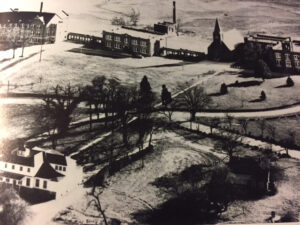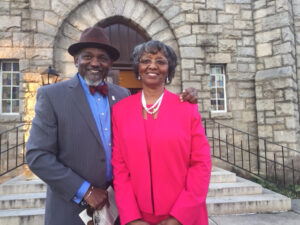
Guest Capcom writer Clarence Williams spent almost five decades working at WRAL-TV before his retirement in 2015. He has always been one of our best Capcom scoopers, and recently shared this great history story:
The History of the Nazareth Community: The Pope Family, the Catholic Diocese, Neighbors of WRAL-TV
 The Nazareth Community in the days when the Catholic Diocese had an orphanage, a school and a chapel on the grounds.
The Nazareth Community in the days when the Catholic Diocese had an orphanage, a school and a chapel on the grounds.
It very difficult to visit the CBC campus without noticing the awe inspiring, majestic beauty of the Holy Name of Jesus Cathedral Church on Nazareth Street.
The recently-completed church was constructed on the site of the longtime Catholic Diocese headquarters and the Cardinal Gibbons High School. The school and the headquarters were moved to make way for this beautiful 2000-seat facility. The area that both CBC and the church is located is called Nazareth in what was a primary bass pro dominantly African-American neighborhood.
As we celebrated Black History Month, the African Ancestry & Evangelization Network (AAMEN) Holy Name of Jesus Cathedral Chapter decided that we wanted to know more about the history of the neighborhood.
We invited Lois Pope Hunter, sister of retired CBC Vice President Paul Pope, to talk to our group because she is a longtime resident who was born here and whose ancestors purchased the a large portion of the land post-Civil War.
The area called Spring Hill was located on land between the Dorothea Dix State Hospital property and what was then the North Carolina College of Agriculture and Mechanic Arts. The land, a part of the Bilyeu Estate, was formerly a vineyard and farm acreage. The Pope brothers – Jackson, Dave, Ransom and William – decided to purchase the land and divide into lots. They had another brother, Nelson Pope, but he did not buy land there with them. The Pope family and many of their descendants still reside in the area.
In the early 1900’s the land that abutted the Popes’ was purchased by the Catholic Diocese, where they built the Nazareth House Catholic Home. The compound contained an orphanage, a school and a Chapel. While the priest, nuns and the kids in the orphanage were all white in the segregated South, they, however, were deeply entwined the community.
 Lois Pope Hunter and WRAL-TV retiree Clarence Williams.
Lois Pope Hunter and WRAL-TV retiree Clarence Williams.
Lois told us that her ancestors, who were farmers and craftsmen, provided food and other resources to the Catholics. Many took jobs at the orphanage caring for the children and clergy. Because the community existed prior to the arrival of the Catholics, Bishop Thomas Fredrick Price asked the families if they would rename the community Nazareth …and the rest is history.
Lois recounted when the WRAL building was constructed and that CBC founder A.J. Fletcher would often stop and talk to the kids playing in the street. He told them to come over and see him when the graduated. Paul Pope did just that working at CBC for over forty years. Many others did likewise and current WRAL-TV Broadcast Technician Patrick Morrow continues the legacy today and lives next to the church.
Other notes of interest:
- Paul Pope tells me that they kept their hogs where the WRAL gardens are located.
- The residents of Nazareth still are given turkeys & flowers…a CBC neighborly expression that has continued to this day.
- The residents often used the old WRAL -TV auditorium for community functions.
(Some of the information in this story can be found in Culture Town: Life in Raleigh’s African American Communities by Linda Harris Edmisten and Linda Simmons-Henry)
Thanks to WRAL-TV retiree Clarence Williams for this capcom story and for these capcom photos.
Lois Pope Hunter speaks to the AAMEN Holy Name of Jesus Cathedral Chapter in honor of Black History Month.
Lois Pope Hunter with one of the Pope cousins, Paul Pope (not the CBC Vice President, but has the same name) who is a parishioner at the Holy Name of Jesus Cathedral. The man in the middle of the photo was actually raised in the Catholic Orphanage.
Lois Pope Hunter and WRAL-TV retiree Clarence Williams.
The Nazareth Community in the days when the Catholic Diocese had an orphanage, a school and a chapel on the grounds.
The Nazareth Community in the days when the Catholic Diocese had an orphanage, a school and a chapel on the grounds.
The childhood home of former CBC Vice President Paul Pope. It was located in what is now the upper CBC parking lot near the State Employee’s Credit Union.